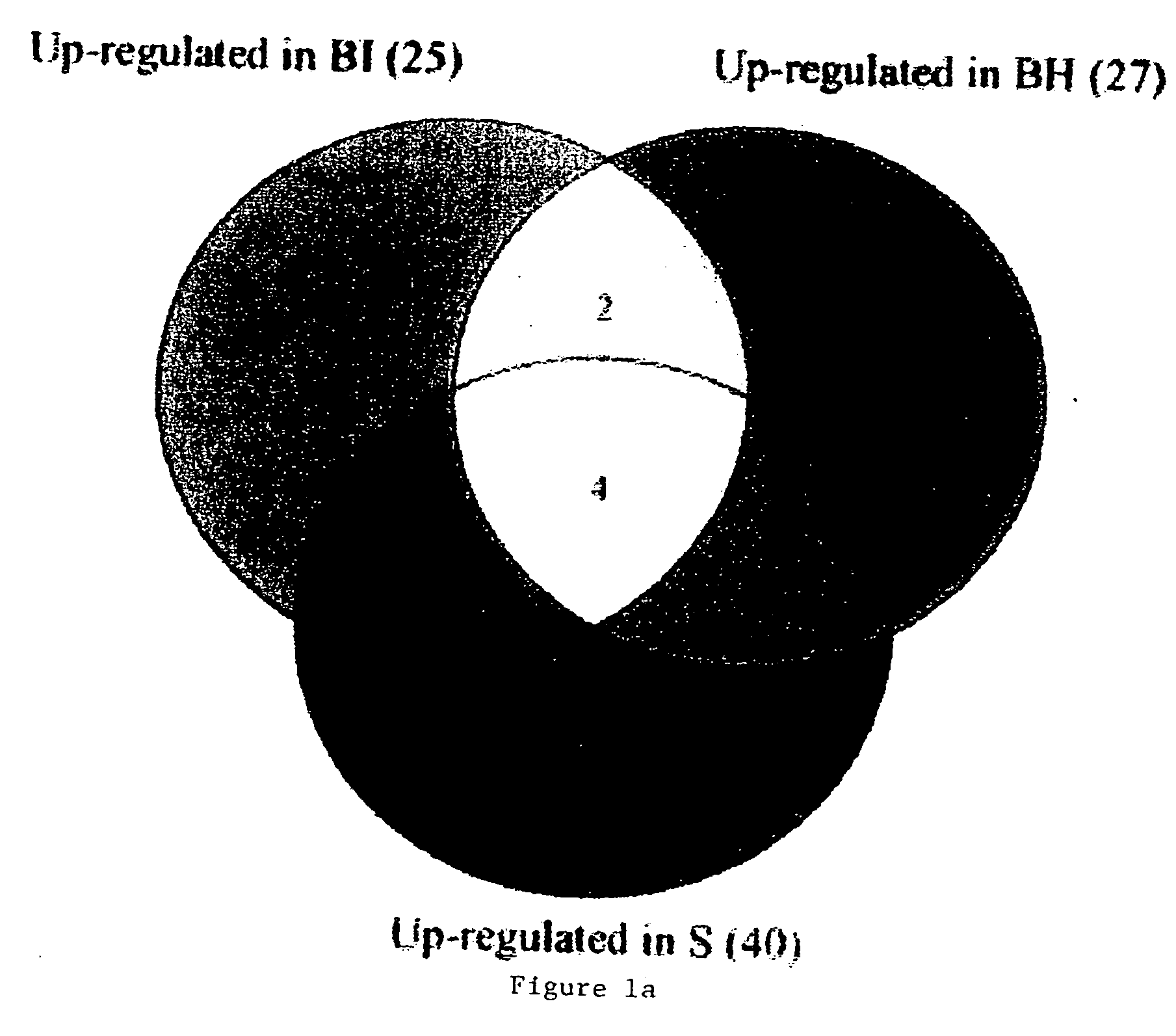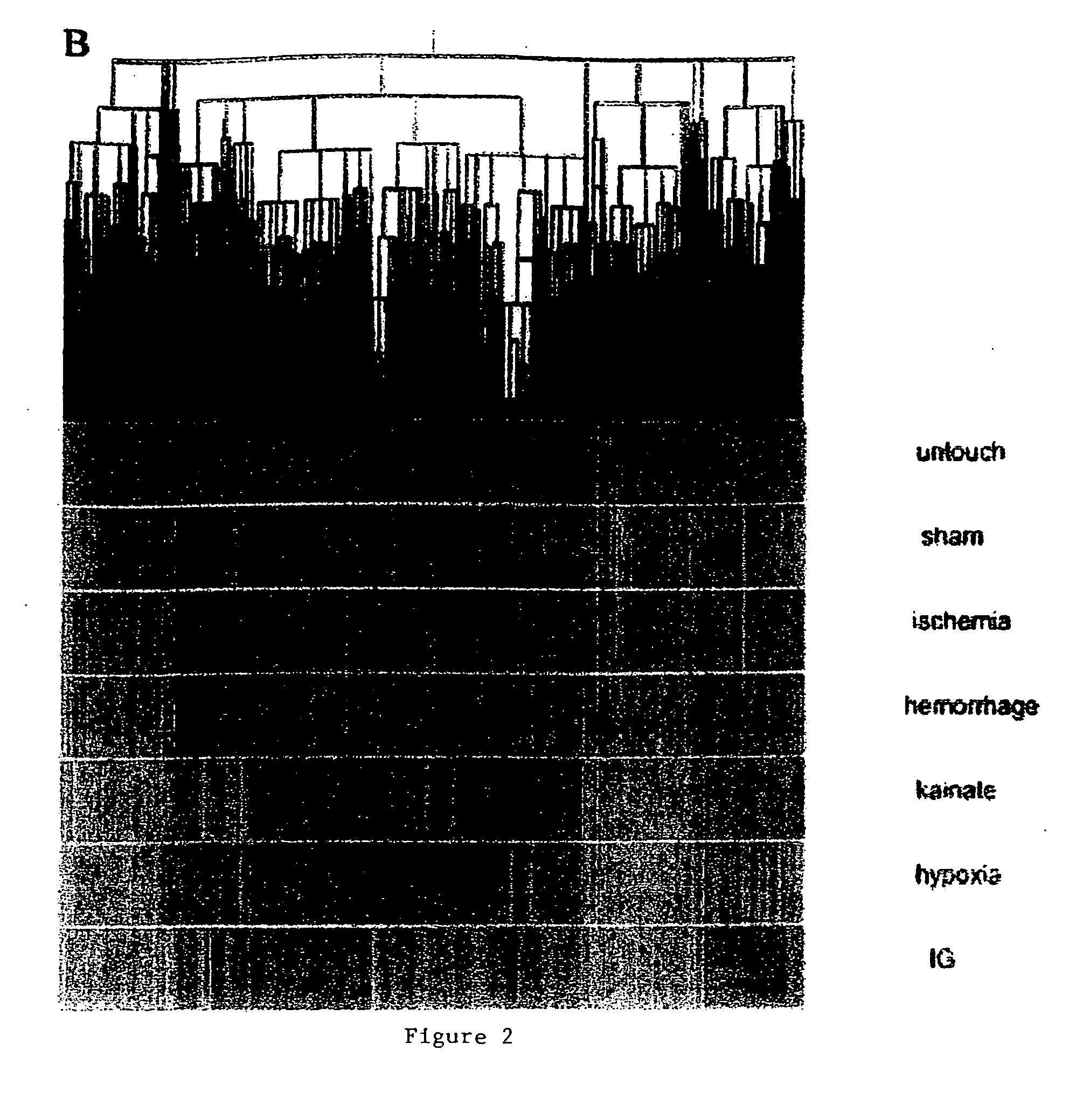Blood assessment of injury
a technology of blood and injury, applied in the field of blood assessment of injury, can solve the problems of difficult transport or use of imaging technology on artificially ventilated patients in intensive care units or post-surgical units, complicated biopsy, and inability to respond to requests regarding medical history or conditions, etc., and achieve the effect of convenient and relatively non-invasive diagnosis
- Summary
- Abstract
- Description
- Claims
- Application Information
AI Technical Summary
Benefits of technology
Problems solved by technology
Method used
Image
Examples
example 1
[0078] This example demonstrates the use of the claimed invention to assess hypoxia, status epilepticus, hypoglycemia, ischemic stroke, and hemorrhagic stroke in individuals. One day after hypoxia, status epilepticus, hypoglycemia, ischemic stroke, and hemorrhagic stroke are produced in adult rats, RNA or protein is isolated from the blood cells and from the brains of these animals. Suppressive-subtractive hybridization is performed on the isolated RNA or protein. The clones, obtained from the suppressive-subtractive hybridization, or the isolated RNA or protein are sequenced. The pattern of genes or proteins expressed in the blood cells following each of these types of injury—hypoxia, status epilepticus, hypoglycemia, ischemic stroke, and hemorrhagic stroke is captured. The pattern of gene or protein expression is defined using an expression method, which then forms a genomic or proteomic organ injury database, which is used in assessing injury in the individuals.
[0079] More speci...
example 2
[0096] This example demonstrates the use of the claimed invention to assess hypoxia, status epilepticus, hypoglycemia, ischemic stroke, and hemorrhagic stroke. One day after hypoxia, status epilepticus, hypoglycemia, ischemic stroke, and hemorrhagic stroke are produced in adult rats, RNA or protein is isolated from the blood cells and from the brains of the animals described in Example 1. The pattern of genes or proteins expressed in the blood cells following each of these types of injury—hypoxia, status epilepticus, hypoglycemia, ischemic stroke, and hemorrhagic stroke is captured on a commercially available microarray (Affymetrix chip). The pattern of gene or protein expression is defined using an expression method, which then forms a genomic or proteomic organ injury database, which is used in assessing injury.
[0097] The data below demonstrates the pattern of gene expression in the blood cells and in the brain following specific pathological insults using genomic profiles based ...
example 3
[0109] This example demonstrates the ability to differentiate between male and female blood samples based on patterns of expression. Blood from over 30 patients is collected from healthy controls as well as from patients with various neurological problems, including headaches, seizures, idiopathic Parkinson's disease, progressive supranuclear palsy, and psychosis. The blood cells are isolated, the RNA extracted, and then processed on commercially available chips (human Affymetrix chips). The RNA is analyzed using the statistical program called SAM (Significance Analysis of Microarrays) to determine the genes expressed more significantly in males as compared to females. As shown in FIG. 3a and 3b, over 20 genes are highly expressed in the blood samples of males as compared to females. The ticks on the X-axis represent individual patients, the first 11 being females and the next 21 representing males. The Y axis shows the expression of a single gene, Dead Box Y Isoform gene and Riboso...
PUM
| Property | Measurement | Unit |
|---|---|---|
| movement | aaaaa | aaaaa |
| disorder injury assessment | aaaaa | aaaaa |
| disorder | aaaaa | aaaaa |
Abstract
Description
Claims
Application Information
 Login to View More
Login to View More - R&D
- Intellectual Property
- Life Sciences
- Materials
- Tech Scout
- Unparalleled Data Quality
- Higher Quality Content
- 60% Fewer Hallucinations
Browse by: Latest US Patents, China's latest patents, Technical Efficacy Thesaurus, Application Domain, Technology Topic, Popular Technical Reports.
© 2025 PatSnap. All rights reserved.Legal|Privacy policy|Modern Slavery Act Transparency Statement|Sitemap|About US| Contact US: help@patsnap.com



